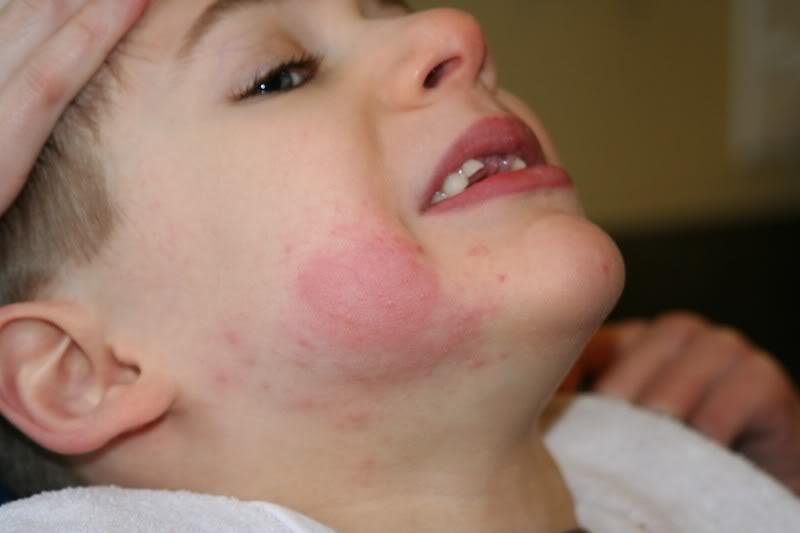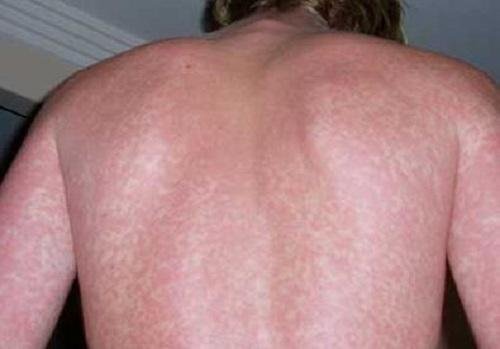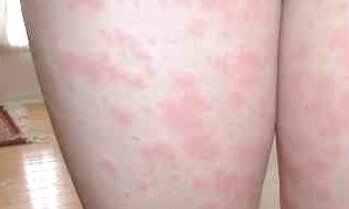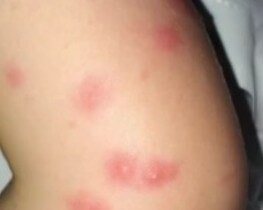What is Lamictal Rash?
Lamictal is one of the brand names for the drug Lamotrigine. It is a long-acting drug that was first synthesized to treat epileptic seizures. This drug belongs to a group of drugs called anticonvulsants. It is used for:
- Epilepsy
- Partial seizures, tonic-clonic seizures
- Lennox-Gastaut syndrome
- Maintenance and treatment of bipolar disorder
Some patients can develop a reaction to the drug, which presents as rash. In some cases the rash can be life-threatening and cause Steven-Johnson syndrome [1].

![]()
Causes of Lamictal rash
The exact cause of Lamictal rash is unknown. Some specialist believe that it is caused by administering too high of a dose when beginning the treatment. also, there is a higher chance to develop rash if Lamictal is used together with valproic acid.
Valproic acid interferes with excretion of Lamictal therefore there are higher blood serum levels of it. The rash is more commonly seen in pediatric patients rather than in adults. The incidence of the rash has been reported at variable rates. Some sources say it is seen in 5-10% cases, while other studies report it to be present in less than 1% cases [2].

![]()
Symptoms of Lamictal rash
The rash can vary in severity. If the rash occurs 5 to 10 days after beginning to use the drug, it is probably Lamictal related. In mild cases the rash presents with red, blotchy patches or hives in a certain area of the body or all over the body. The red spots are widely spaced and might be itchy. Usually the rash resolves in 10 to 14 days and is not accompanied by other symptoms that could possibly explain the rash.
Serious rash occurs less commonly. It is characterized by the involvement of mouth, tongue, face and genital/anal area. The rash is more prominent on the neck and upper trunk. Fever or flu like symptoms usually accompany the rash. Other symptoms include:
- Red or purple looking rash
- Tender to touch
- The rash merges and appears swollen
- Redness and swelling all over the body
- Hospitalization might be required
- Complete blood count, blood urea and creatinine levels and liver enzymes should be normal [4]
Types
There are four main types of Lamictal rash:
- Hypersensitivity reaction- fixed eruptions, itchiness, exanthema, urticaria, edema
- Rash associated with mood stabilizers: photosensitivity, loss of body hair, increased pigmentation.
- Severe, life threatening conditions: Steven Johnson syndrome, toxic epidermal necrolysis, severe hypersensitivity reaction, exfoliative dermatitis.
- Exacerbation of existing skin condition: acne, psoriasis, seborrhea, hyperhidrosis [3].
Side effects of Lamictal
Besides the rash, Lamictal can also cause other side effects like:
- Dizziness
- Double or blurred vision
- Headaches
- Insomnia or sleepiness
- Fatigue
- Chest pain
- Peripheral edema
- Dermatitis, dry skin
- Increased libido
- Rectal hemorrhage
- Migraine
- Tremor[4]
Management of Lamictal rash
Discontinuation of Lamictal
Therapy guidelines state that in case rash occurs after 5 to 10 days of initiating the treatment, use of Lamictal should be stopped, regardless of the type or severity of the rash. Initial dosing of Lamictal can play an important role in the possibility of rash. If the patient has had reaction to the drugs, the therapy should be introduced in very small dosages.
In patients who use valproic acid, Lamictal should be given in smaller dosages because of the increased risk of rash. Lamictal is metabolized by process called glucuronic acid conjugation therefore medications that induce or inhibit this process can cause variability in the half-life or Lamictal.
Usually the half-life of Lamictal is 24h. Use of carbamazepine, phenytoin, phenobarbital and estrogen-containing contraceptives shorten this time to around 14 hours. Valproic acid increases the half-live of Lamictal to around 70 hours. One of the biggest issues of Lamictal use, is that the exact therapeutic dosage is not known and it has to be administered based on the therapeutic response of every patient [3,5].
Therapy
Usually if the rash is mild, it goes away after a time and doesn’t require any treatment. The rash should resolve within 10 to 14 days.
If the rash is severe, medical help should be sought. Usually the treatment includes using antihistamines and steroids. In severe cases, when the throat is closed up, intubation of the patient might be required.
In case of severe side effects, like toxic epidermal necrolysis, monitoring of fluid intake and urine output should be observed. Therapy usually requires electrolyte balance regulation with intravenous fluids. Also, loss of body temperature should be prevented and parenteral feeding has to be started. Extra precaution should be taken to prevent bacterial infection. In some cases prophylactic antibiotics are given [5,6].
Pictures


![]() References
References
- What is Lamictal rash: http://psycheducation.org/treatment/mood-stabilizers/the-big-three-for-bipolar-depression/lamotrigine-lamictal/details-on-the-lamotrigine-rash/
- General drug information: https://medlineplus.gov/druginfo/meds/a695007.html
- Symptoms, causes and management: https://academic.oup.com/ijnp/article/12/2/257/668826/Lamotrigine-associated-rash-to-rechallenge-or-not
- Symptoms and side effects: http://drugsdetails.com/lamictal-lamotrigine-rash/
- Treatment: https://www.ncbi.nlm.nih.gov/pmc/articles/PMC2658298/
- Treatment of toxic epidermal necrolysis: http://emedicine.medscape.com/article/229698-treatment?src=refgatesrc1#d11

I have developed a rash several years after taking Lamictal XR, or Lamotrigine ER 200mgx3 at bedtime. The rash is not exactly like the photos, my dermatologist has not been able to help. I also have “bruising.” A bruise may appear and last a few days, but I have not injury or fall to cause such. Note: I do have a balance problem, but I know the bruises I previously mentioned is not from falls.
The greatest concern is a call from doctor’s nurse yesterday. (1) I was requested to get a lab work asap. In mid September, 2017 a lab was performed to measure the levels of Lamictal and Onfi in my blood. I was told that the results of the Lamictal were not valid for some careless mishandling. They want the present level of Lamictal, yet, (2) I was told to discontinue my Lamictal XR immediately and to have a prescription of Briviact 50 mg (2/day) filled asap.
What good will a blood test for the med. level do if I discontinue using the medicine? Also, if I quit taking the entire dose of Lamictal, I am asking for problems. If I forget one dose (600mg) at bedtime, I get into trouble within at least 3 days, even if I try to squeeze 1 of the 3 pills in over a few days. Should a med be discontinued immediately and use of a med. began, without first talking directly to the doctor?
Look up Steven Johnson Syndrome and you tell me if you should stop the Lamictal?
Actual!y, not all rashes become SJS, my Psychiatrist has viewed my cheetahs which looks and feels like gives after a dosage increase. His advice is to drop back to the original dose and as !ing as the rash does not spread, blister or give me flu symptoms still see if it settles.
If not need to come off it and once cleared start again in slow, low doses of change meds. If I see changes I am to stop and get to hospital. Some that get a small area affected can take antihistamines and it goes in 7-10 days. The thing is to always get it looked at when it appears. My rash does not resemble severe reactions.
To drop to nothing and hit severe depression would be awful but if rashes don’t go or do turn to Steven-Johnson Syndrome is of course life-threatening. The best thing is if the rash appears see your Psychiatrist or doctor immediately then take their expert advice. But don’t panic as it’s a percentage of rashes thatch on to SJS. Become familiar with the symptoms. Currently I am day 6 of my chest being red and sore and itchy. If still there in 3 days when I see him i will have to stop the Lamotrigine.
I was prescribed lamictal and lithium for depression and less than a week later developed a horrible rash on my belly and chest, looking much like photo 1. Went to urgent care on a Sunday, two nurse practicioners checked and ruled out detergents, they determined it was the lamictal. I was prescribed steroid cream and told to take an antihistimine every night but the symptoms aren’t going away and the rash is not getting better. It’s very swollen on the right side, very sensitive and feels like a burn. My psychiatrist trashed me for coming off the lamictal *as directed and as recommended on the label if a rash occurs* and “not telling her” even though I actually DID tell the therapist who was supposed to relay the information as soon as I was told to stop taking it and that I shouldn’t have discontinued it without her seeing my blood work from urgent care, and they didn’t take blood!! I don’t know what to do but I have a feeling she is overstepping what is even legal.
i am on Lamotrigine prescribed 10 years ago,, only recently come out with rash which can be itchy and blisters… i hate it im so worried too about coming off it as it has eased my awful depression. why are we prescribed drugs that can cause fatal illness. Im so worried about getting that Steven disease. blimey don’t know what i am going to do.